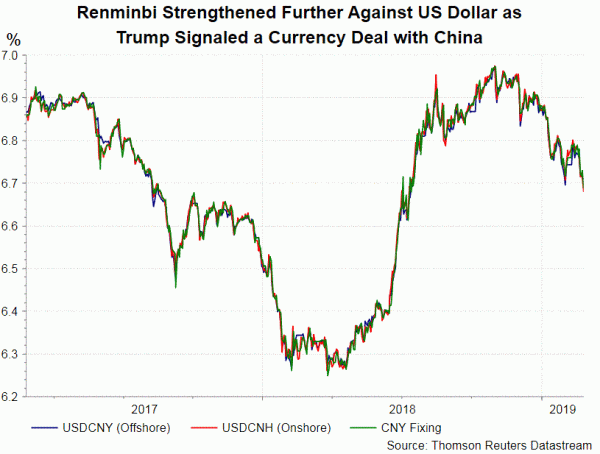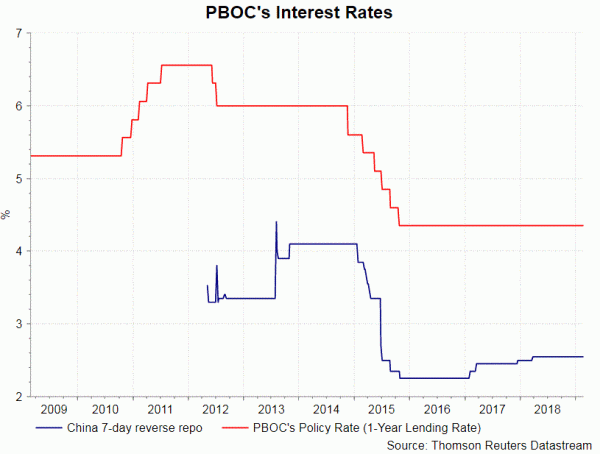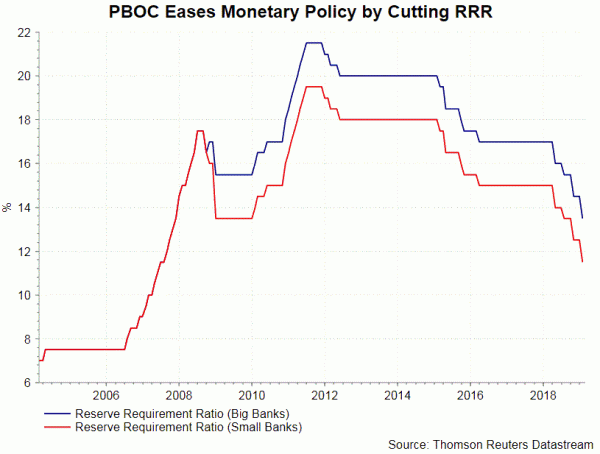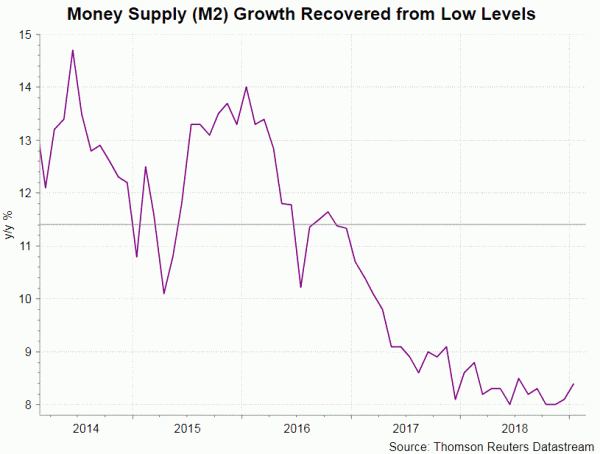Market sentiment improves further as Trump sent more hints on trade truce extension and “substantial progress” on striking a trade deal with China. Indeed, his indication that a deal on “currency manipulation” has send renminbi (Chinese yuan) to the 7-month high against the US dollar. Meanwhile, China January money/ credit report has shown signs of transmission of its monetary easing to the market, also lifting confidence about the country’s economic outlook. Yet, these events should not alter the government’s monetary policy. That is, it would continue with the more accommodative monetary policy, with focus on lowering reserve requirement ratio and injecting liquidity via open market operation (e.g. reverse repos). Rate cut, while not unlikely, would still be the last resort.
 China’s credit data surprised to the upside in January. Much was driven by seasonal factor, front-loaded borrowing ahead of Lunar New Year holiday in February. Total social financing (TSF) increased to RMB 4.6 trillion, while RMB lending rose to RMB 3.2 trillion. Both readings exceeded market expectations. Broad money supply (M2) grew +8.4%, beating +8.1% in December 2018 and consensus of +8.2%. The improvements in money supply growth and lending are signals that PBOC’s RRR cut and reverse repo operations are taking effect.
China’s credit data surprised to the upside in January. Much was driven by seasonal factor, front-loaded borrowing ahead of Lunar New Year holiday in February. Total social financing (TSF) increased to RMB 4.6 trillion, while RMB lending rose to RMB 3.2 trillion. Both readings exceeded market expectations. Broad money supply (M2) grew +8.4%, beating +8.1% in December 2018 and consensus of +8.2%. The improvements in money supply growth and lending are signals that PBOC’s RRR cut and reverse repo operations are taking effect.
PBOC has only resumed reverse repos last week, the first time after Lunar New Year holiday. The pause during the period had caused speculations that the central bank would adopt a less easy monetary policy. Moreover, the fact that the 7 -day reverse repo rate has stayed unchanged at 2.55% since March 2018 has also made some to expect a less accommodative policy stance. We do not see any change in PBOC’s monetary stance. At the 4Q18 monetary report released on February 21. PBOC mentioned that it would “maintain a prudent monetary policy stance”. Note that the term “neutral”, which appeared in the third quarter report, was removed. This suggested that the policy stance is more biased, to the accommodative side in our opinion.
 Indeed, PBOC’s monetary policy is never neutral over in recent years, according to international standard. It reduced RRR four times in 2018 and once so far this year. Meanwhile, in January, it relaxed criteria for banks’ eligibility for RRR cuts, so that more banks can lower their RRR and lend more money to the market. CICC estimates that such adjustment could free up as much as RMB 400B. Last week, the central bank adopted the so-called Central Bank Bill Swap (CBS) for the first time so as to encourage lending to the private sector. While the central bank denied that it’s a form of QE, such denial has nonetheless evidenced the easing effect of such instrument.
Indeed, PBOC’s monetary policy is never neutral over in recent years, according to international standard. It reduced RRR four times in 2018 and once so far this year. Meanwhile, in January, it relaxed criteria for banks’ eligibility for RRR cuts, so that more banks can lower their RRR and lend more money to the market. CICC estimates that such adjustment could free up as much as RMB 400B. Last week, the central bank adopted the so-called Central Bank Bill Swap (CBS) for the first time so as to encourage lending to the private sector. While the central bank denied that it’s a form of QE, such denial has nonetheless evidenced the easing effect of such instrument.
 All these moves have proved that China has been adopting monetary easing. Economic growth slowdown in China has accelerated since US- China trade war began in mid-2018. Stimulus using both monetary and fiscal measures has been implemented. Signs that the trade war is coming to an end should not end these stimulus. While no detail of the trade agreement has been disclosed, China might be obliged to let the renminbi appreciate more significantly to accommodate Trump’s demand. This could hurt China’s exports sector, and hence, the overall growth outlook. On the other hand, a forced appreciation in renminbi might allow PBOC more flexibility to cut interest rates. It is believed that the central bank has been reluctant to lower interest rates as it fears that would trigger a sharp fall in renminbi and capital outflow. All in all, the events evolving still support PBOC to continue a easing monetary policy.
All these moves have proved that China has been adopting monetary easing. Economic growth slowdown in China has accelerated since US- China trade war began in mid-2018. Stimulus using both monetary and fiscal measures has been implemented. Signs that the trade war is coming to an end should not end these stimulus. While no detail of the trade agreement has been disclosed, China might be obliged to let the renminbi appreciate more significantly to accommodate Trump’s demand. This could hurt China’s exports sector, and hence, the overall growth outlook. On the other hand, a forced appreciation in renminbi might allow PBOC more flexibility to cut interest rates. It is believed that the central bank has been reluctant to lower interest rates as it fears that would trigger a sharp fall in renminbi and capital outflow. All in all, the events evolving still support PBOC to continue a easing monetary policy.














